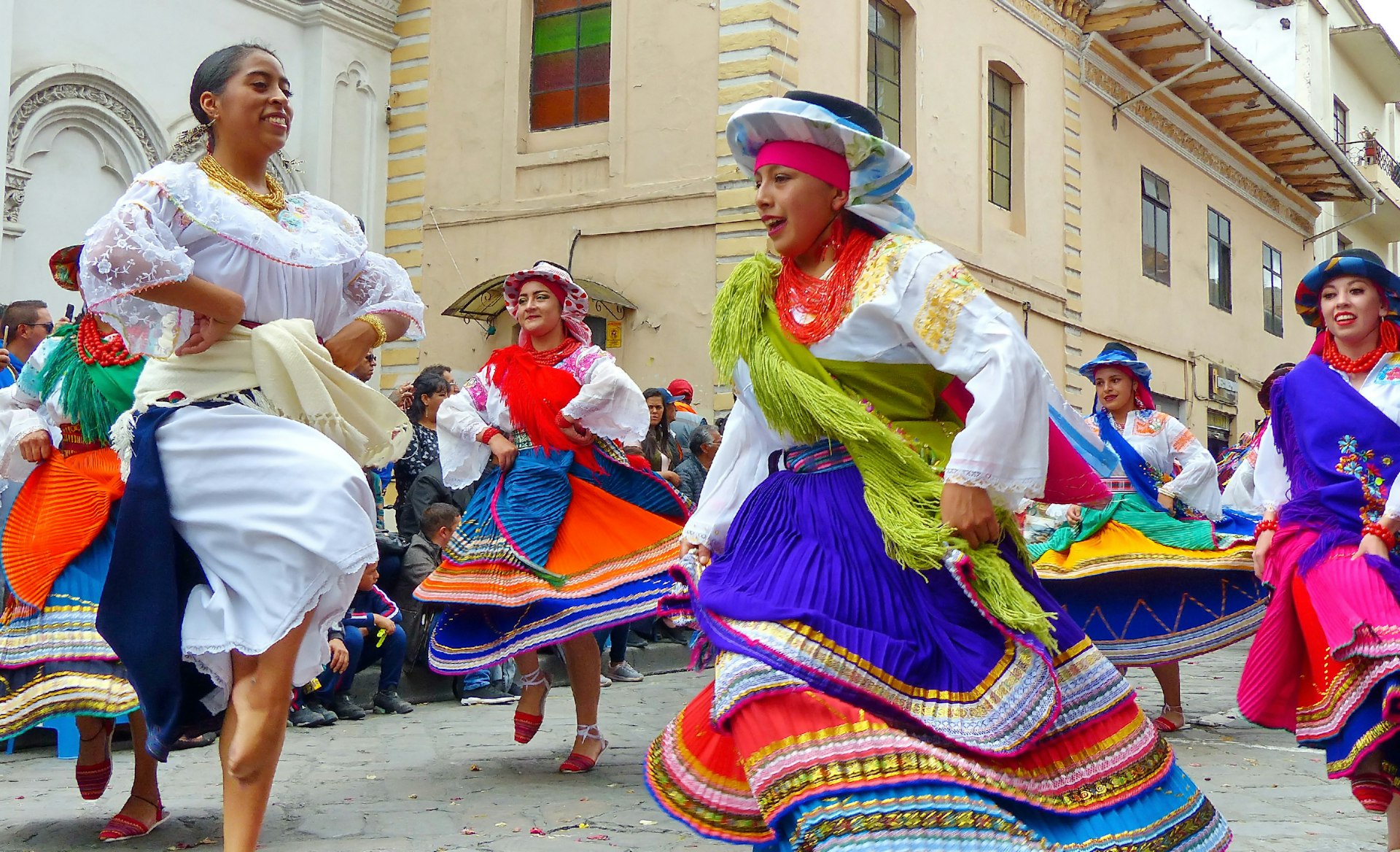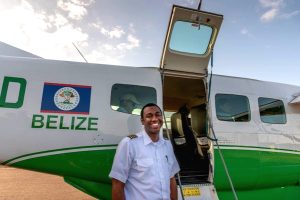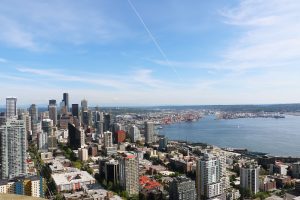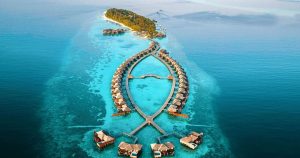
Ecuador offers some of the most incredible outdoor experiences on earth, from surfing on beautiful beaches to treks through the Amazon jungle. The fourth-smallest country in South America offers experiences to rival anything in Brazil, Argentina or Chile, all packed into a small space that’s easy to explore by bus, boat or plane.
With top-flight natural wonders such as the Galápagos, the Andes and the Amazon Basin, the opportunities for wildlife watching and bucket-list adventures are limitless in Ecuador, and this compact country also provides myriad cultural attractions.
Whenever you need to pause to acclimatize to the altitude or rest after an expedition, Ecuador’s cities and villages offer live music, delicious local cuisine, energetic markets, historic architecture and unique festivals to enjoy. Here are the best things to do in Ecuador.
Discover the world’s most intriguing experiences with our weekly newsletter delivered straight to your inbox.
1. Marvel at the wildlife of the Galápagos Islands
If we’re talking must-dos, going wildlife watching in the Galápagos Islands sits at the top of the list in Ecuador. A trip to these remote islands sitting 906 km (563 miles) off the Ecuadorian coast is a South American safari, both terrestrial and marine, starring such charismatic creatures as seafaring iguanas, blue-footed boobies, gigantic Galápagos tortoises, diminutive penguins and a mind-bending diversity of birds and sea life.
Planning tip: Visiting the Galápagos needn’t cost a fortune. If your budget won’t stretch to an all-inclusive cruise, DIY travelers can fly in and take advantage of public ferries between accessible islands, land-based tours and even last-minute discounts on organized cruises.
 A girl snaps a picture of a marine iguana on the Galapagos Islands © shalamov / Getty Images
A girl snaps a picture of a marine iguana on the Galapagos Islands © shalamov / Getty Images
2. Spot humpback whales from Isla de la Plata
Nicknamed ‘The Little Galápagos’ or ‘The Poor Man’s Galápagos,’ tiny Isla de la Plata is a more affordable alternative if your budget won’t cover a Galápagos visit. The island is accessible on a day trip from Puerto López or Salinas, and you’ll see blue-footed boobies, frigate birds and albatrosses, as well as tortoises, lizards and crabs. The ideal time to visit, though, is from June to September, when humpback whales migrate through these waters. Time it right, and you’re almost guaranteed to spot one of these majestic creatures – not a bad consolation prize for missing the Galápagos!
Planning tip: During the whale migration season (June to September), whale-watching tours combined with visits to Isla de la Plata leave regularly from Puerto López. The journey to the island takes over an hour and can be rough; bring a rain jacket for the wind and spray.
 The historic city of Cuenca is a vibrant hub for Ecuadorian culture © IRYNA KURILOVYCH / Getty Images
The historic city of Cuenca is a vibrant hub for Ecuadorian culture © IRYNA KURILOVYCH / Getty Images
3. Hit the highlands from Cuenca
One of Ecuador’s most exquisite cities, historic Cuenca has a stunning mountain backdrop and streets full of 16th-century colonial architecture. It’s a gorgeous base for local treks and day trips to the archaeological site of Ingapirca, Volcán Chimborazo, Parque Nacional Cajas and local villages with busy markets frequented by Indigenous communities. Take time to explore Cuenca’s cathedrals, museums, handicrafts markets, lively cafe culture and an appealing clutch of quality restaurants and microbreweries.
4. Venture deep into the rainforest along the Río Napo
For a once-in-a-lifetime experience, pull on some knee-high rubber boots, hop into a motorized canoe from Coca and head deep into Ecuador’s Oriente, where the Río Napo melts into the Amazon River. The experience doesn’t come cheap, though – even ‘budget’ river lodges are all-inclusive, and all food, water, supplies and staff must be shuttled in by boat. However, lodge stays are a requirement, both to protect Indigenous tribes from unwanted contact and to protect visitors from the hazards of the jungle.
Days spent exploring the Napo and its tributaries will include treks through dense rainforest in search of rare birds, monkeys, tapirs and even anacondas. If you’re lucky, you may spot pink river dolphins, river otters or the air-breathing arapaima – one of the world’s largest freshwater fish.
Planning tip: Along with the natural wonders of Amazonía, take time to visit Kichwa villages that work with local lodges to introduce visitors to their culture through sustainable, community-run tourism projects.
 Ecuador’s national parks provide a home for elusive jaguars © tane-mahuta / Getty Images
Ecuador’s national parks provide a home for elusive jaguars © tane-mahuta / Getty Images
5. Explore the Parque Nacional Yasuní
Parque Nacional Yasuní is a stunning, remote corner of Ecuador and the largest national park on the mainland at 10,227 sq km (3949 sq miles). Providing a home for rare wildlife, including jaguars, nocturnal curassows and giant armadillos, this Unesco Biosphere Reserve is one of the most biodiverse places on Earth.
The reserve is also home to the small, self-isolated Tagaeri and Taromenani tribes, who continue their traditional coexistence with the jungle without interference from the outside world. Most Río Napo lodges arrange visits to other indigenous communities that welcome outside visitors and trips to see colorful parrots descending in a spectacular display along the riverbanks at Yasuní’s famous salt licks.
Planning tip: To explore the reserve, you can stay within the park’s boundaries at eco-lodges, such as the Napo Wildlife Center, or camp on an adventurous tour from Coca. Either way, the trip will include wildlife and cultural encounters.
6. Hike the Quilotoa Loop
Popular for good reason, the multi-day Quilotoa Loop trek traverses verdant hills and valleys, connecting the scattered villages of Cotopaxi province. Along the way, you can peek into local art galleries, hit Kichwa markets (if you time it right) and take in the gorgeous green crater lake of Laguna Quilotoa. The Quilotoa Loop offers a scenic combination of cultural immersion and cardiovascular exercise – trek with a local guide to get the best from the experience.
Planning tip: The driest season for hiking the loop is June to September; start from Latacunga, prep for cold and wet weather and bring trekking poles to deal with the uneven pathways.
 Quito’s historic streets warrant several days of exploring © f11photo / Shutterstock
Quito’s historic streets warrant several days of exploring © f11photo / Shutterstock
7. Hop on a bike in Quito
The ciclopaseo is Quito’s version of the ciclovía – a chain of officially sanctioned cycle routes that shut down 30km (18.6 miles) of the city’s streets to motorized traffic every Sunday from 8am to 2pm. The city’s cycling culture promotes sustainability, supporting people-centered events, cafe culture and pop-up markets, and a bike is a great way to explore the Unesco World Heritage-listed Old Town, with its colonial architecture and soaring rooftop views.
But don’t make the mistake of limiting your explorations of this high-altitude capital city to the historic center. Outlying neighborhood pockets such as La Floresta and La Mariscal house jazz bars, art galleries and cozy restaurants where you can ease back and feel like a local.
8. Go whitewater rafting around Tena
The rivers around Tena offer everything from gentle rafting trips to thrilling whitewater on Class III to Class IV+ rapids in the humid lowlands of the Oriente. Licensed operators have booking offices around town that can organize a rafting trip best suited to your abilities. If adrenaline isn’t your thing, Tena also happens to be an appealing little lowland town with a cute malecón (esplanade), an active bar scene and a buoyant blend of local and ex-pat energy.
Planning tip: For rafting trips, September through February is the best season for white water, with the peak rafting months being October and November.
 A surfer makes the most of the waves in Montañita © FOTOGRIN / Shutterstock
A surfer makes the most of the waves in Montañita © FOTOGRIN / Shutterstock
9. Surf the breaks of Montañita
The beaches of south-central Ecuador are famed for their beach breaks, and Montañita has cemented its position as the country’s landing spot for novice and expert surfers. The boho atmosphere attracts backpackers, surf lovers and solo travelers, who revel in Montañita’s party scene and make full use of the beaches. For easy access, fly into Guayaquil and take a two-hour bus ride as an alternative to the nine-hour bus ride from Quito.
Planning tip: Rather counterintuitively, the best time of year to come is during Ecuador’s rainy season from December to May, when the sun is warmer, and the air feels fresher after bursts of rain.
10. Buy snacks and souvenirs in the Otavalo market
The biggest and best-known Indigenous market in Ecuador, the colorful Otavalo market is open daily, year-round. Vendors offer everything from fresh produce to Panama hats, wood and leather handicrafts, jewelry and alpaca-wool sweaters. Seek out interesting things to eat, such as llapingachos (Ecuadorean fried potato cakes) from food stands based in and around the market.
Planning tip: The busiest market days are Saturday and Wednesday – get here early to beat the crowds. If you’re not staying in town, it’s easy to visit the market on a day trip from Quito.
 The towering Cotopaxi volcano is one of Ecuador’s most striking landmarks © Natursports / Shutterstock
The towering Cotopaxi volcano is one of Ecuador’s most striking landmarks © Natursports / Shutterstock
11. Climb to the summit of Cotopaxi
At 5897m (19,347ft), Volcán Cotopaxi’s conical peak can be seen from several provinces away. On a day trip from Quito or Latacunga, you can hike, mountain bike or ride horseback on its rugged slopes, which are protected as part of the Parque Nacional Cotopaxi. While you explore, look out for local wildlife such as condors and deer. Climbing to Cotopaxi’s summit requires some planning and a bit of training with a licensed guide, but the experience of summiting at dawn is well worth the midnight start.
12. Meet the creatures of the Cuyabeno Wildlife Reserve
The Cuyabeno Wildlife Reserve is another hugely biodiverse park in the Oriente, with humid ecosystems ranging from seasonally flooded woodlands to permanently inundated rainforest. These damp zones are home to tapirs, caimans, monkeys, sloths, pink river dolphins and hoatzin (large, prehistoric-looking birds), as well as hundreds of other bird species. Despite the reserve’s remoteness, visiting can be cheaper than taking a trip to Parque Nacional Yasuní.
Planning tip: To help protect Cuyabeno’s Indigenous people and wildlife, the rainforest can only be visited as part of an organized package, with accommodation at Cuyabeno Lodge, Jamu Lodge or one of the other lodges in the reserve.
 Playa Los Frailes beach in Machalilla National Park is one of Ecuador’s best beaches © Holger Leue / Getty Images
Playa Los Frailes beach in Machalilla National Park is one of Ecuador’s best beaches © Holger Leue / Getty Images
13. Bliss out on the central beaches
Unless you’re a surfer, Ecuador probably won’t be top of your list of beach destinations, but its beautiful coastline won’t disappoint lovers of sand, sea and sun. December through April is the best season for sunning and surfing in Manabí and Esmeraldas provinces, where you’ll find a string of stunning beaches.
Canoa is a laid-back surfing village with a little nightlife and backpacker amenities. To the south, a hike through Parque Nacional Machalilla will deliver you to Playa Los Frailes, one of Ecuador’s most beautiful beaches, backed by steep bluffs. To the north, the fishing village of Mompiche has miles of peaceful sand and, blessedly, not much else.
14. Trek to the summit of El Altar
Ecuador’s fifth-highest mountain, Volcán El Altar tops out at 5319m (17,451ft) and is one of three mighty volcanoes within Parque Nacional Sangay. A trek to the summit, which can be tackled overnight or spread over three days, is a fascinating journey through varied ecosystems, ranging from tropical forest to páramo (alpine tundra) and glacial lagoons.
Planning tip: Treks to the top of Volcán El Altar can be arranged in Riobamba; access is from the Hacienda Releche near Cadelaria, a 30-minute bus trip from Riobamba.
 Vilcabamba is surrounded by gorgeous hiking country © nicolasdecorte / Getty Images
Vilcabamba is surrounded by gorgeous hiking country © nicolasdecorte / Getty Images
15. Relax in the mountain town of Vilcabamba
Easygoing vibes pervade the air in the mountain town of Vilcabamba, perhaps contributing to the longevity that locals are said to enjoy. The atmosphere is definitely conducive to slowing down and soaking up the bucolic mountain setting. Whether you choose to do this from the porch of a café, from the back of a horse or on foot on a trail winding through undulating Andean valleys is up to you. Post-hike, Vilcabamba plies travelers with massages, meditation and gastronomic love.
Planning tip: Vilcabamba also provides a great base for trips to Parque Nacional Podocarpus and birding at Tapichalaca Reserve; make arrangements with local adventure tour operators.
16. Soak away your worries at Papallacta
Who couldn’t use a soak in a mineral-rich hot spring? If you feel you’ve earned a little luxury after getting soaked in high-altitude downpours or buffeted by wind on a hut-to-hut trek, book a stay in Papallacta (ideally, on the night before your flight out of Quito) for a decadent spa-style hot springs experience.
Spend the evening and morning soaking in outdoor hot springs, watching steam curling into the mountain air while the warm mineral waters restore your spiritual and physical balance. If you can’t get to Papallacta, our hot springs runner-up is Baños, a busy hub for outdoor activities with spas on every corner.



